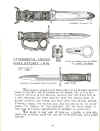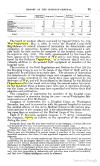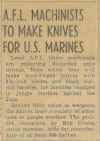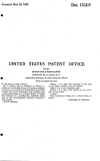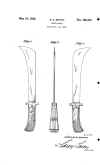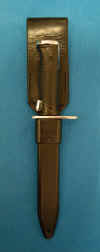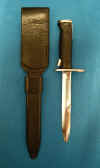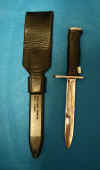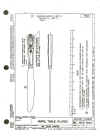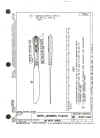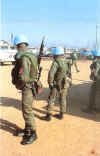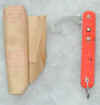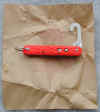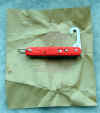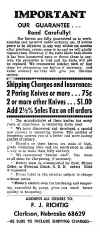January 2010
Quote:
"The world is full of obvious things which nobody by any chance ever observes."Sherlock Holmes, The Hound of the Baskervilles
M7 Knuckle Grip
Received a report from good friend John Gibson on the M7 knuckle grip seen in Cole IV page 110. (Did you ever notice Cole IV has a really funky smell to it? As soon as you open the book it hits you right away. I have owned dozens of them and they all smell the same, must be the glue they used in it?) Anyway the grip panels Cole shows are marked on the inside. John noticed a set at the Louisville show last year and spoke with the seller. They were his dad’s and he was selling them for his mother. His father had passed 22 years ago and he was cleaning out the basement of all the things his father had collected over the years. His father had made the grips, quite a few of them, and they had been lying in the basement collecting dust. John asked if he still had the mold or any paperwork but it could not be found, probably disposed of years ago if there even was any. John also noted a few sets around the show so several had been purchased. We know they existed when Mr. Cole drew them up but can not date them at all before then. The mold is gone as is the paperwork. They are now lost to time. We bring this up only because you may encounter a set, that are out there, not that rare as once thought and sold rather cheaply at first. They have been seen priced from $350.00 to $650.00, they are the legitimate item but sort of pricey. Thanks for the info John!
OL Bayonet Blanks
Shown below are some super photos of raw bayonet blanks for the M1905 as produced by Oneida Cutlery. These show several stages in the machining of the M1905. Pretty Cool.
Model of 1905 Hospital Corps Knife
Google books is getting better all the time. The obvious issue is the time it takes to read all these great volumes they now have online. Here is a page from a War Dept report on the adoption of the Model of 1905 Hospital Corps Knife. They were tasked to come up with a suitable knife by Special Order No. 104 on May 4, 1903. Testing was completed in July 1903 with the Board recommendation to adopt the new design. The design was approved by the Secretary of War and in production when the report was being written prior to the Annual Report date of June 30, 1904. We know 295 were made in the first fiscal year and dated 1904 although the official model designation is 1905. I have not seen that report but would love to. Come to think of it I have never searched the Hospital Corps records either. Not enough time…
Knife Photos
We receive questions on knives all the time. For most it is a simple answer and for others we need photos. I always ask for good clear photos showing the knife in focus and in full in at least one shot. Lots of cut up close ups out of focus are worthless. Asking for a clear photo or scan is not asking a lot. In any case our good friend Bernard Levine sent me HIS instructions for knife photos for identification uses. Here is what he requests:
Main rules:
1 BIG
2 Plain neutral background
3 NO flash.
4 Straight on, not angled
5 Whole knife, not random bits
Knife photos should be large image size but low resolution, suitable for monitor viewing:
1. Plain smooth light gray background, such as Matte board. No colors or textures or grids. Never black.
2. Diffuse light -- cloudy daylight, or bright lights bounced off of a white ceiling.
Do NOT use on-camera flash. Turn it off. TURN OFF THE FLASH!
3. Use a tripod or other solid camera support.
4. Do NOT use "electronic / digital zoom." Optical zoom is OK.
Sample:
http://www.svalbardrepublic.org/scagel-canoe/scagel-canoe-PC050025s.jpg
For smaller knives one can usually get better results using a flatbed scanner (not an all-in-one -- they don't have enough depth of field).
Cover the knife and the entire glass with a large piece of white paper, NOT the scanner lid.
Here is what 2x = 200% scans look like:
http://svalbardrepublic.org/ebay/lovelawn-s-a300.jpg
http://svalbardrepublic.org/ebay/whitt2horn-jl.htm
VIEWS for each knife (fixed blades):
1 straight on shot of entire knife and sheath side by side, front side, life size or larger.
1 straight on shot of entire knife and sheath side by side, back side, life size or larger.
Be sure to flip over the sheath, too (it's amazing how many people forget)
Include a ruler in one of the above views, along the outside edge of the image, NOT touching the knife or scabbard.
1 close-up of each marking on knife or sheath. Do NOT use "electronic / digital zoom." Use optical zoom and macro only.
Do not take random close-ups. Take large full views.
Do not take angled photos, unless needed to show an important detail.
Turn off the flash!
VIEWS for each knife (folding knives):
Straight on shots of entire knife 2x = twice life size or larger. Open, part
open, closed. front and back.
Include a ruler in ONE of the above views, beside but NOT touching the knife
or scabbard.
Shots down into the joint of each end, showing the relation between the blade and
spring -- full open, part open, closed.
Close-ups of markings, unless they are shown clearly in the full views.
Other views only if requested by me. Do not send random close-ups.
Before emailing, convert image files to .JPG format.
Sounds simple enough aye. Thanks Bernard!
Quotes:
"If you kill enough of them, they stop fighting."Curtis Lemay
More Shop Made Knives
An old article clipped from a newspaper was sent to us by Carolyn Landon. In her letter she remembered her father getting his Union involved in making knives for Soldiers and Marines shipping off without a knife. We do not have the date or name of the paper this article ran in but the family was living in San Diego at the time of the war.
M6-M1 Combo,
Here is a strange one, an M6 handle and locking mechanism with an M1 blade. It looks to be professionally done and is finished nicely. The guard is silver soldered in place. It could be a mock up for design purposes or it could have been made in someone’s back yard. Does anyone know for sure about this strange piece?
Camillus MIL-K 818C Knife Dates
When Camillus closed the plant it was like a time warp, the machines just stopped one day, everyone went home and just never returned. The machines were loaded with steel, machines were set up properly to just start running. Boxes and bins were loaded for the workers to arrive the next day and start to work. While walking around through every possible corner of the building I could, I noticed the work stations for building the MIL-K 818C knives were loaded and ready to assemble knives. I went through the bins and all the blades were dated 2006. There were thousands of them. I can say with certainty that Camillus made that pattern knife with a year date from 1957 to 2006 and every year in between as I have one of each year. It is definitive with 2006 being the last date. Little known is that Camillus also made that pattern in 1949, the knife is a little different in design and materials but they made them and date stamped them as well.
M3 Type Knuckle Knife
Our friend Mitch Wilkins sent us this photo of a knuckle knife he found. I do not know who made it but I have seen this type repeatedly through the years. It is a quality made knife with good machine work and good leather skills as well. I have not seen many of these but enough over the years that they stick in my mind so that begs the question of who made then, when did they make them and why did they make them? Can anyone offer any facts on this case? As stated they have been around and seen over the years so we can assume that a few of you own them out there, what was the story when you bought yours?
Another Cuban Mk2
Our good friend and amazing photo hound Gunbarrel noted on the Cuban photo of Raul Castro wearing the Mark 2 send us another photo taken during the Revolution of Camilo Cienfuegos also wearing a Mark 2. Must have been the knife of choice in Cuba, wonder if they still have them there just like the 1957 Chevy’s and the 1959 Harley Davidson's they still repair?
Cuban Collins Machete
Along with the above photo we have one of a young soldier wearing a long Collins fancy machete. Collins machetes were used in battle during the Spanish American War as a sword to show a rank or status not always just as a machete. Suppose some things never change.
Trends…
An amazing trend has developed recently of buying an item as a whole and splitting it up and selling the pieces. Wall Street grasped that 20 or so years ago with buying companies and selling them off as pieces. It has been done with land for centuries and continues to this day. It has recently hit the collectable knife market where a knife and sheath are sold separately and bring in big dollars. There are folks that only collect military groupings and they are becoming increasingly rare as they are broken up and sold for the parts. Some of the objects that are not worth the time and effort are just disposed of. It seems on the surface a travesty but in many cases the knives or bayonets were originally shipped to the military without sheaths and only mated up when issued. Many collectors store their knives out of the sheaths and when a collection is sold or the collector passes on the collection is sold with all sorts of miss matched sets. It happens all the time and has happened for years. What is new, at least to me is that the pieces are bringing more money as individual objects. It was only a short few years ago that a mint knife without the proper matching sheath would bring about half or less of what it was worth if it had the matching component. Not so these days, the two mint items sold separately could bring up to 25% more. This is not a statement of what should or should not be done with an historical object entrusted to your care, just an observation.
Krag Bowie Bayonets
We hear tell of a few Krag Bowie style bayonets recently spotted that were in fine condition and had a very similar stamping flaw. A portion of the 0 in the 1900 was missing as was a portion of the S in the US. Same seller owned both, no pictures could be taken but it sure seems odd. Any information on a recently made reproduction that is really good work? We don’t know of any but it may be so.
eBay Sniping
I snipe I use an auction sniper I never bid more than I am willing to pay
I only bid on items I want myself
I bid to win, everytime I never bid less than what I believe to be full price. If I win the auction for less that is good. If it is significantly less that is great.
Quote:
There are two kinds of stones, as everyone knows, one of which rolls, the other gathers moss.Amelia Earhart
February 2010
Quote
"Better to write for yourself and have no public, than to write for the public and have no self".
Cyril Connolly
Official National Guard Knife
Here we have a photo of a real National Guard knife sent to us from Kim James. No doubt about it in my mind it came from the National Guard. It is tang marked Geo. Schrade Knife Co. B’port Ct. PAT. APP. FOR The American Eagle is embossed on both sides and reads The National Guard Defends America. Works for me.
M8 Scabbard Thongs
We see all sorts of fancy knots on the thongs in the M8 type scabbards. The original packing called for a leather thong that was pulled through the hole and left as is. Later we find these leather laces wrapped around the bottom of the scabbard in some packages. When the standard was changed to the cotton lace it was again looped through the hole and tied off. It appears more up to the packing person that any standardization other then one loop through the hole and left alone. All the fancy wrappings are from the man it was issued to and we see a plethora of fancy knots.
Knife, Emergency, Curved
A wonderful article clip sent to us from good friend Dustin Clingenpeel from a WW II technical Manual. The write up stated:
Knife, Emergency, Curved, Maj. William C. Beaver, MC Aero Medical Laboratory, Wright Field, Dayton, Ohio.
The knife shown here, a valuable component of the emergency medical equipment carried aboard bombardment airplanes, is used to slit the clothing of a wounded man in order reach and treat his wounds. Knives are to be installed in all bombardment airplanes passing through staging areas for overseas destinations. Each knife (a Class 17B item, Stock No. 7900-470950) is contained in a leather sheath with two "Lift the Dot" fasteners for mounting. Requests, based on the requirements in overseas combat use of 2 knives per heavy bombardment airplane and 1 per medium bombardment airplane , may be submitted to The Director, Air Technical Service Command, Wright Field , Dayton, Ohio.
What a great clip, many folks have called us on this one over the years as Mr. Cole shows it as a life raft knife and a period drawing showing one in the hands of a man in a raft. Yes the knife pattern was used in life rafts but typically not in the pattern leather sheath with lift the dot snaps. The raft type were in plastic sheaths and of the glue on type. The snap and leather sheath were for aircraft.
Quote
"Nations have passed away and left no traces, and history gives the naked cause to it – one single, simple reason in all cases; they fell because their people were not fit."Rudyard Kipling
Folding Machete Patent
Good Friend Brian Huegel sends us a copy of a Design Patent on the World War Two era folding machete used in the Emergency Sustenance Kits. The patent was listed to Richard D. Brown of Olean, NY. It was a 14 year design patent with application made on February 16, 1942 and granted quickly on May 19, 1942. Fascinating the a Design Patent held by Brown of Olean was produced by Camillus and Cattaraugus and not by Kabar, or was it…
Classical Music Anyone…
Love the music, love the gun and love the fireworks. Click and enjoy!
Thanks to Paul Mabry
Intrenching Knives
Springfield Armory reports producing two (2) Intrenching knives in fiscal year 1878. I would love to see one of those two knives. Do you suppose that they are the typical Intrenching pattern of the 1880 knife or something different? I think different.
Marine Corps Bayonets
Back when the Marines were using the M1903 rifle they designated unserviceable rifles I&C for Inspected and Condemned. These were often stamped with the I&C markings and retained for bayonet practice. It seems in some documented cases the breakage of the M1905 bayonets were causing a financial issue so the Marine Armorers welded steel onto the barrels and these were issued for bayonet practice. I have not seen one of these rifles with the welded on bayonet blanks but there are documents that state it was carried out.
Marine Spotter Bayonets
While on the subject we also note that seven (7) M1905 bayonets were modified for use as spotting scopes by the USMC. They milled a slot into the pommel of the bayonet, stuck it in the ground and a squad member would sight through the slot and tell the shooter of his target and his aim point. Another one I have not seen or heard of a real one anyplace. Again they are documented as being made and tested.
M1905 Italian Bluing Method
It is a little known fact that Ordnance set up shop in France during World War One and adopted a simplified method of bluing used by the Italian Army. Many M1905 bayonets went through this process. Not a bright buffed bluing and not a dull Parkerizing, just different.
Plated M1905 bayonets
A report filed in 1933 concluded that all the bayonets in use by the US Army 15th Infantry troops in China had been plated. The USMC Horse Marines used plated M1913 Patton sabres with dress uniforms to patrol with. Smedley Butler had done the same thing with his Marines, chromed bayonets, but went one step further, he had all their helmets brightly buffed painted and polished. Showing off in China in the early 1930’s was a way of life and one up-manship was alive and well in the services. Although never officially approved by Ordnance these were US weapons and gear plated and issued to the troops. You are far more likely to encounter a plated bayonet used by the local American Legion or the VFW but never rule out the possibility of it being used in the military.
More Plated Bayonets
Plated bayonets are still secured today. Many official Honor Guard Platoons are issued with plated bayonets for all sorts of duties they carry out. The most often thought of use is the Army’s 3d Infantry Regiment known as the Old Guard. They provide the soldiers for Arlington National Cemetery and many other official Washington D.C. uses. They use the M14 rifle with the M6 bayonet, plated, held in a black M10 scabbard with a black harness leather frog to attach to their belt. In fact the M1, M5, M6 and M7 are all known to be officially plated and in use by US forces at this present time. (2010) These are all real bayonets that have been plated for this specific use. In fact a few years ago I remember seeing a contract for M6 bayonets let to Imperial Knife Co., to be plated and provided dull to prevent the plating from flaking off on the sharp edge.
Model of 1905 Bayonet Scabbard Inspectors
I found a note I had misplaced with a listing of scabbard markings found under the throats of M1905 bayonet scabbards. The first scabbard I inspected was marked RIA / 1906 / HEK prominently on the leather were it could be seen by all, the typical marking. But under the metal throat was stamped RIA / 1906 / EMS. A second scabbard was marked RIA / 1906 / WFB in the typical fashion but under the throat was found ELR / JA / HEK. None of these marking would ever be seen if the throats were not removed. They were sitting in a pile of several other scabbards all in junk condition. Interesting in that possibly they were inspected at different points of fabrication.
SWORDLESS SAILORS
Last year (2009) the families of graduating midshipmen of the U.S. Naval Academy in Annapolis are being told in writing to leave at home or in their vehicles all "ceremonial swords" and anything else "that might be considered a weapon or a threat by screeners" for the commencement ceremonies. This was mis-reported in the Washington Times as being a new order due to the current president being the speaker, it is not. Also among the restricted items are umbrella’s, with the wet spring we had been having a lot of those sailors and their families probably ended up wet also. The reason given is that the current Dress White uniform does not require the sword as a part of the outfit. According to the Academy press release this restriction has been in effect for several years. By tradition many families bring a sword to present to the newly minted Navy or Marine Corps officer, now it must be done in the parking lot. A sign of the times.
Quote
"It is a capitol mistake to theorize before one has data. Insensibly one begins to twist facts to suit theories, instead of theories to suit facts."Sherlock Holmes, A Scandal in Bohemia.
March 2010
Quote
"There is no such thing as equality. It is a beautiful and worthy ideal, but highly impractical as it discriminates against those who excel at what they do."
Unknown
Obsolete Wood
Did you know the Army declared wooden pistol grips obsolete in 1885, it appears the newly formulated hard rubber grips were all the rage, invest in plastics…
Silverware
While researching I found a design for official ships silverware designs. I copied the knives, table and dessert, to show here. This set was approved as official on 12 Dec 1952 and went through two revisions before being cancelled on 25 Sept 1972. The file did not have the new pattern in it so we can’t tell you what they changed to. I hate to speculate on what these were used for and by whom, can anyone point me to why they would be on a ship? Admirals, maybe visiting dignitaries?
M1917 2REP Knife
We hear from our good friend SGM John Larsen Ret. with a photo from a book he has showing the cut-down Model of 1917 bayonet in wear by a member of the French Foreign Legion 2e Regiment Etranger de Parachutistes. The 2d REP is the tip of the spearhead of the French rapid reaction forces. It fills what we would call a special forces roll typical to what the US Rangers would be called upon to do. Interesting to note the scoped sniper type weapon while the Legionnaire next to him with the FAMAS has the rifles bayonet. This photo was taken in Bosnia circa 1993 by Yves Debay. The knife or one like it may still be in use today, quite a history for the M1917! Thanks SGM!
Hackman – Moran
We hear from reader Pat Lyons of a knife he inherited from his father. On searching the web Pat landed on Knife Knotes 9 in which we stated that W.F. "Bill" Moran sold Hackman survival knives during the Vietnam Period when he could not produce his hand made knives fast enough. Mr. Moran made his own sheaths for the Hackman knives and we wanted a picture of one. Well the knife Pat inherited from his father is a Hackman survival pattern with a leather sheath stamped on the rear By / WF Moran / Limekiln / MD. It is a curious fold over pattern with a leather belt loop riveted on the rear and a large retainer strap with snap. Not at all military in appearance but it has the Moran flair to it. And in wonderful as new condition, thanks Pat!
Schrade Walden MC-1 knives
Here we have a few photos of the Schrade made MC-1 knives that are fresh in the wrap. Our good friend Art Green just picked up a few in a deal and sent us these photos. Interesting to note that the storage paper is marked July 1960. This in itself does not mean they were made then but it usually indicates a very close relationship as the paper was typically used fairly quickly in the factories. These knives, four altogether are like new. Thanks Art for the peak into the history like it appeared in 1960.
Hollow Handled Parsons
We received a nice letter from a Ms Amie Parsons Pack on the topic of the Parsons hollow handled knives we ran a piece on in Knife Knotes X. It seems Ms Pack is the daughter of Mike Parsons, the maker of the unknown knife we featured. Ms. Pack confirms the knife was made in the 1980’s. It seems Mike was a custom knife maker for about 20 years located in Texas. He made mainly hunting knives but loved to do something different and large Bowies were among the many styles he would have fun making. His marking was the name PARSONS and a number would often be on the blade if it was a standard model. The knife shown is the 11th made of that style. Mike would set up at gun shows to sell his wares. Knives were also often sold to friends of friends with word of mouth being the best referral. Mike was good friends with Jim Pugh who started him in the custom knife making field. Amie tells us that Mike passed away a few years ago. Among her favorite memories are going to gun shows with him and the smell of leather sheaths. Ms. Parsons Pack is currently looking to purchase a knife made by here father so if you know of one you can contact her at Amie Parsons Pack apack7@comcast.net 615-305-4239
Quote
"Who actually cares if a laser guided 500 lb bomb is accurate to within 9 feet?"
Unknown
That M3 Knuckle Type Knife Again
Here we have photos supplied by Barry Olson of the M3 type knuckle knife mentioned in a previous Knife Knotes. This one is marked inside the knuckle bow with MAR CO in a large sans serif type stamping. This is the only marked example we have seen to date. We still do not know what to think of this one?
Richtig Test
Well we don’t know what to list this under, ballzy or stupid? We just received a few photos of someone testing the validity of the Richtig Believe it or Not article where Richtig would hammer one of his knives through a railroad spike and still have a shaving sharp knife blade. It sounds like a great marketing gimmick but with a multi thousand dollar knife not something one would want to try for themselves. Well here we have a test case without risking any of our own money or knives. Yes that is a Richtig that was hammered into an old railroad spike. You make the call.
Knives and Holsters
We often see photos of soldiers with a knife tucked in behind a holster. This seemed to be a fairly standard way of carrying a knife on the pistol belt, and efficient as well in space. This one was sent to us by our good friend Gunbarrel asking about the knife shown. It is a cut-down Klewang and the sheath is the correct model for the sword. These were used early in the Pacific campaign while machetes were in short supply. The Army captured many of these in the islands. The Japanese also used the swords as a badge of rank with the local islanders, cut down to a certain length they would signify the individuals status. So it came to be that the Americans also used the same rank structure when occupying the same islands. This is a superb photo that shows the non official weapon is a typical carrying position. Thanks GB.
Some Drawing Numbers
While going through some blueprints I decided to compile some of the dates and revisions of the ones I have on hand. These are the drawing dates not adoption dates so it will certainly vary but should give us somewhat of a decent time line at least on these items.Model of 1917 Bayonet, Drawing 20-2B-32
July 2, 1917 Original Drawing Date
April 20, 1918 Revision 1
Nov 8, 1918 Revision 2
Nov 20, 1918 Revision 3
Redrawn as 20-2B-42 but undated
Model of 1917 Scabbard, Drawing 20-2B-28July 2, 1917 Original Drawing
Oct 10, 1917 Revision 1
Oct 31, 1917 Revision 2 (Removal of leather and double hook mounting tab)
Feb 25, 1918 Revision 3 (Mouth piece spring width change from .407 to .467)
Mar 12, 1918 Revision 4 (Add the chape staples to the drawing no changes)
Sep 30, 1918 Revision 5 (Thicker ferrule / chape tip material .028 to .031)
Feb 20, 1919 Revision 6 (Add mouth piece spring rivet)
June 15, 1920 Revision 7 (Add mouth piece rivet)
Mar 1, 1938 Revision 8 (Add List of Specifications to drawing no changes)
??? Revision 9 (Remove packaging from list of Specifications, no changes)
Sep 18, 1942 Revision 10 (Whole new design with Beckwith Tenite scabbard)
Model of 1905 Scabbard, Drawing 20-2B-3
Sep 18, 1905 Original Drawing
??? Revision numbers not listed on drawings, just dates, this is the first one I have.
Dec 14, 1915 Metal Krag type swivel hanger still standard
Mar 15, 1916 Outside diameter of swivel washer made smaller 1.00 to .85
May 1, 1916 Mouthpiece top locking latch changed to Case Hardened
July 10, 1916 Drain hole eyelet removed
May 24, 1917 New designation Model of 1905 Modified adds leather sleeve & double hook
Feb 25, 1918 Remove third rivet hole in leather sleeve added above
Aug 20, 1919 Redesign throat sleeve and add new throat chape design
Mar 1, 1938 Add List of Specifications to Drawing, no changes
M1 Bayonet, Drawing 20-2B-54
Feb 18, 1943 Original Drawing with Bowie point cut down M1905
Apr 16, 1943 Change to Spear Point purpose made M1 blade
July 8, 1943 Change to List of Specifications for test and packaging only
Mar 29, 1944 Change to List of Specifications for plastic inspections only
M7 Scabbard, Drawing 20-2B-56
Apr 6, 1943 Change from M3A1 to M7 designation
July 7, 1943 Redrawn with no changes
Not a lot to go on but it adds to the growing list of information, like pieces in a puzzle. When I feel energetic again I will pull out some more drawings and do another list… never enough time in the days…
Quote
"When your time comes to die, be not like those whose hearts are filled with fear of death, so that when their time comes they weep and pray for a little more time to live their lives over again in a different way. Sing your death song, and die like a hero going home."
Chief Tecumseh
If you wish to be placed on the mailing list to be notified when the Website is updated, drop us a line. E-mail us here trz123@comcast.net
Check out our books for sale, some good ones, new and used have just arrived! We have the Coniglio M3 Trench Knife book back in stock also
Frank Trzaska trz123@comcast.net
